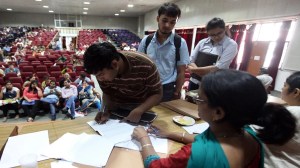- India
- International
RBI on demonetisation: Rationing cash, rationing words
The silence of the top brass of the RBI, especially Governor Urjit Patel, who has spoken once since demonetisation, has become a subject of debate.
 Two former Deputy Governors that The Indian Express spoke to on the issue of a possible change in the external communication strategy of the RBI.
Two former Deputy Governors that The Indian Express spoke to on the issue of a possible change in the external communication strategy of the RBI.
Just short of a month into the currency recall exercise, the Reserve Bank of India’s silence has been a subject of much debate. The head of the central bank, Governor Urjit Patel, who has spoken just once since the Centre annulled nearly 86 per cent worth of currency in circulation on November 8, is slated to brief after the monetary policy committee meeting on Wednesday.
But the silence is not restricted to just the new Governor, who took charge in September. In the following two months of October and November, there have been all of three public speeches by the RBI top brass — two by Deputy Governor R Gandhi and one by Deputy Governor NS Vishwanathan.
WATCH VIDEO | Reserve Bank Of India Keeps Repo Rate Unchanged Post Demonetisation
During the first eight months of this year — between January 1 and September 3 (Patel took over on September 4) — there were 38 speeches by RBI Deputy Governors and Executive Directors at an average of over four speeches a month. Post September 3, there were six speeches by Deputy Governors and Executive Directors up to the end of that month, but sources in the RBI indicated that a majority of these were committed to before the change at the helm of the central bank.
While a couple of months may be too short to draw a conclusive verdict on a change in the central bank’s external communication strategy, a clearer indicator was the Reserve Bank’s fourth bi-monthly monetary policy review for 2016-17 on October 4 — the first under Patel. Alongside the announcement that the RBI and the government had constituted a six-member Monetary Policy Committee (MPC), the Report for October 2016 issued by the central bank started with a study of cross-country experience of 15 countries on the number of MPC meetings and the press conferences that usually follow the meetings in order to explain the stance of monetary policy. “A survey of country practices suggests a central tendency among major central banks to hold four press conferences a year, although the number of MPC meetings may be higher,” the statement said, in summation.

Patel’s penchant for not talking is evident from the fact that during the entire three years that he was a DG at the RBI, there was just a single speech delivered by him at an awards event at Welingkar Institute of Management Development and Research, Mumbai on January 12, 2015. Analysts read the then DG’s comments as being uncharacteristically effusive in the praise of the schemes initiated by the NDA government, especially phrases such as the “Make in India” vision/strategy providing “a much needed ‘focal point’ to inculcate durable competitiveness in key sectors of our economy”, “uncertainty has been lifted in key sectors like coal and spectrum” and the “Jan- Dhan Yojana” scheme being a “game-changer” that “provides an unprecedented scaffolding and a springboard for meaningful financial inclusion and, concomitantly, substantial financial deepening of our economy”.
Two former Deputy Governors that The Indian Express spoke to on the issue of a possible change in the external communication strategy of the RBI, especially on the demonetisation exercise, broadly concurred with view that the currency recall process, including the communication aspect, could have been handled better.
One of them, however, indicated that there was an impression that the RBI, before Patel, was sometimes “speaking out of turn”, especially on issues that did not strictly come under the central bank’s remit. Since the currency recall exercise was launched, Patel has been under attack over the implementation of the scheme, with the All India Bank Officers Confederation calling for Patel’s resignation citing the need for him to take “moral responsibility for the current crisis in the country” while former Prime Minister Manmohan Singh said in Parliament that the implementation of the scheme reflected “very poorly on the Prime Minister’s Office, the finance minister’s office and on the Reserve Bank of India”. Singh, who had served as the Governor of RBI in the mid-1980s and as finance minister subsequently, said: “I am very sorry that the Reserve Bank has been exposed to this kind of criticism, which I think is fully justified.”
Even as Patel desisted from making any public statement well into the second week after the currency demonetisation was announced, the finance ministry has backed him to the hilt. Economic affairs secretary Shaktikanta Das, in a November 23 briefing, brushed aside a pointed query on Patel’s conspicuous absence in all of the government briefings since the day the scheme was announced. “It is not relevant who speaks. I am speaking on behalf of the government, I am not speaking here in my individual capacity. So, therefore, it is irrelevant whether I am speaking or somebody else is speaking,” Das said in response to the query on Patel’s absence. Then on November 27, finance minister Arun Jaitley defended Patel after Congress leader Jairam Ramesh accused the RBI Governor of “sacrificing” the central bank’s autonomy and sought his resignation over the handling of the partial demonetisation exercise. In a tweet, Jaitley said, “An unfair attack by Jairam Ramesh on the RBI Governor. Must politicians attack those who cannot defend themselves in the same tone?”
During the last two years, when Patel was still DG and Rajan was at the helm, a total of 48 speeches and lectures were delivered by the RBI top brass (Governor, DGs and EDs) in 2015 and 65 in 2014. Of these, Rajan alone accounted for 17 speeches. A day before he demitted office, Rajan had, characteristically, delivered a speech on ‘the independence of the central bank’ at Delhi’s St. Stephen’s College.
Globally, too, there are divergent views on how central banks should communicate. A May 2016 report from the Federal Reserve Bank of Dallas warned that officials’ public commentary could be counterproductive as the public is already suffering from information overload, obscuring whatever message policy makers are trying to get through. “A more effective communication strategy for the central bank could be to speak less often and make each speech count by delivering a more focused, cohesive and concise message,” writes Antonella Tutino, an economist at the Dallas Fed had noted in the May report. On the other end of the debate, Sweden’s central bank, the Sveriges Riksbank, in a series of steps towards opening up its communication lines, has launched its own YouTube channel that aimed at putting together the broadcasts from its press conferences and analysts’ meetings, together with other films on the bank’s operations.
Sweden’s central bank has been on the forefront of simplifying communication, to the extent of winning the unthinkable for a central bank —an award for using plain and simple language to explain its decisions. Other, including the Bank of England and the ECB, have taken a cue from the Swedish central bank and launched their YouTube channels.
Apr 24: Latest News
- 01
- 02
- 03
- 04
- 05






































